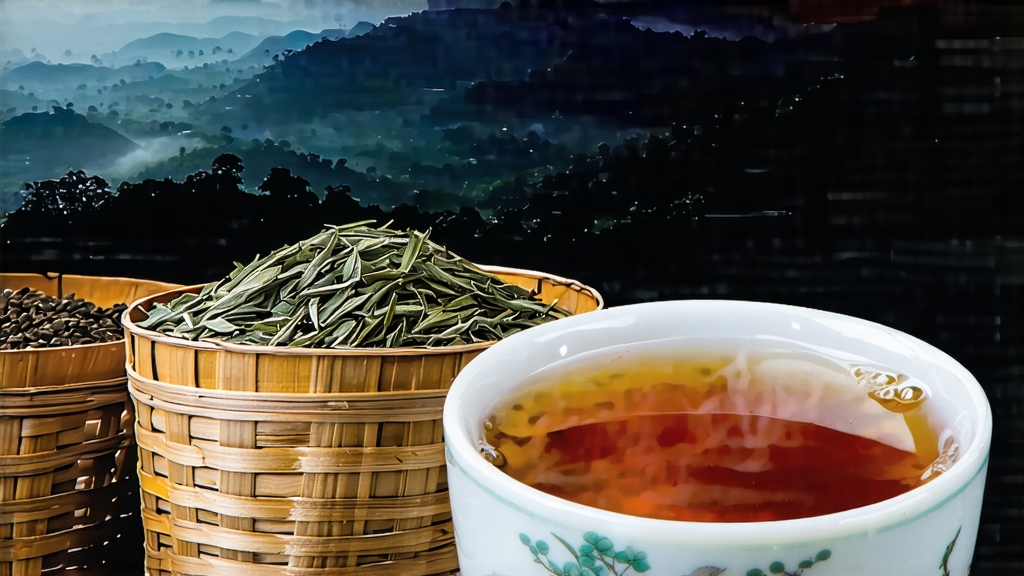
Tucked away in the humid, karst-pocked mountains of southern Guangxi, Liu Bao tea has spent four centuries quietly fermenting while its more famous cousin, Pu-erh, soaked up the global spotlight. To the uninitiated, “dark tea” is often assumed to be a single style, yet Liu Bao possesses a personality so distinct that seasoned tasters can pick it out of a blind line-up by scent alone: a cool, almost medicinal whisper of camphor and pine that arrives just after the first swallow, like the ghost of an ancient forest.
The story begins during the late Ming dynasty, when the port of Wuzhou on the Xun River became the last inland stop for imperial caravans heading to Southeast Asia. Compressed baskets of dark, glossy leaves were lashed to the sides of bamboo rafts and floated downriver to Hong Kong, then onward to Malacca, Penang, and the kitchens of Kuala Lumpur where the tea is still stirred into bone broths and served at breakfast. Locals claim the name “Liu Bao” simply means “six forts,” a reference to the six stockades that once protected the mountain pass leading to the producing villages. Whatever the etymology, the tea’s fortunes rose and fell with the river trade; when steamships replaced rafts, Liu Bao slipped into obscurity, hoarded by grandmothers who believed it cooled the blood after too much lychee or fried durian.
Unlike Pu-erh, which is grouped into “raw” and “ripe” categories, Liu Bao is always post-fermented, but the degree of fermentation is calibrated in subtler gradients. The leaf itself comes from a cultivar known locally as Zhong ye zhong—medium-leaf Assamica—grown between 200 and 600 meters on red, iron-rich clay. Spring picking adheres to the san pian er zhao rule: three open leaves and a bud, plucked before the monsoon swells the leaf cells and dilutes flavor. Once basketed, the leaves travel by motorbike along switchbacks to the village of Liudong, where the real alchemy begins.
The first step is a brief sun-wither, no more than thirty minutes, just long enough for the edges to soften and the grassy volatiles to blow off. Next comes sha qing, “killing the green,” but here the wok is cooler (180 °C) and the toss lighter, preserving enzymes that will drive the microbial drama ahead. While still warm, the leaves are piled 40 cm deep in a corner of the factory that smells of wet earth and bruised bay leaf; workers cover the heap with jute sacks and wet canvas, kick-starting a 12-hour “wet rest” during which internal temperatures climb to 45 °C. This is not the 60-day wo dui of Pu-erh; it is a gentler, shorter fermentation that leaves the leaf spine intact yet stains the veins a dark rust.
What follows is Liu Bao’s signature move: the steam-basket press. A bamboo cylinder, 50 cm tall and lined with banana leaf, is packed with 35 kg of the warm tea. Live steam shoots through the center pipe for 90 seconds, softening the cellulose just enough to bond the leaves when a wooden lid is ratcheted down by foot-powered rope. The basket is then slid into a drying tunnel heated indirectly by charcoal embers; over the next three days the tea loses 60 % of its moisture and emerges as a dense, glossy column that can be peeled apart like geological strata.
Ageing is where Liu Bao diverges most decisively from other dark teas. The ideal warehouse is an old brick building on the lower slopes of the Daqingshan, its windows left cracked so that mountain fog can roll in at night. Bamboo baskets are stacked three high, separated by slats of camphor wood that repels insects while donating its perfume to the tea. Every spring and autumn a team of women known as cha po—“tea grandmothers”—rotate the baskets, mist the outer layers with river water, and sample the core with a long brass needle. A five-year Liu Bao offers cocoa and dried longan; at fifteen the liquor turns burgundy and the camphor note crystallizes into something reminiscent of Vicks VapoRub—strangely attractive when balanced by a rock-candy sweetness that lingers in the throat.
To brew Liu Bao well, one must unlearn the gongfu